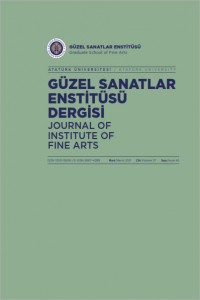An Overview of The Great Seljuk Period Kiosk Mosques in The West of Iran: Barsiyan and Gurve Mosques
Abstract
In The Great Seljuk period, Iran experienced one of the brightest eras in terms of architecture and art. During this period, the Central Asian architectural tradition that came with the Turks added a new color to the Irani architecture, which is based on an old and deep-rooted tradition. Thus, a new tradition emerged under the name of Turk-Iran, and this tradition was carried to Anatolia with the Turks. In this period, we encounter new plan types that emerged especially in mosque architecture. One of them is small kiosk mosques. These small buildings gradually form the domed section in front of the mihrab/altar. In this study, after examining the two kiosk mosques, Barsiyan and Gurve Mosques in the west of Iran, the general characteristics of the mansion-type mosques were summarized and tried to be explained.
Keywords
References
- Archnet. (t.y.). Terken Hatun Kubbesi Planı [Kroki]. https://archnet.org/sites/1621/media_contents/62966
- Berkli, Y. (2011). Türk sanatında Avrasya üslubunun evreleri (Avrupa ve İslâm sanatına etkileri). Atatürk Üniversitesi Yayınları.
- Dilmun. (t.y.). Barsiyan Camii restitüsyon ve günümüzdeki hali [Fotoğraf]. http://www.dilmun.ir/articles4.html
- Godard, A. (1387 hş.). Asar-i İran (Cilt.4). (A. Sarvghad Moghaddam, Çev.). Bonyad-ı Pajuheşhayi İslami.
- Hatem, G. A. (1390 hş.). Mimari-ı İslami-ı İran dar Dori-ı Selcugiyan. Jahad-ı Danişgahi.
- Heiranpour Şan, S. (2015). Barsiyan, Gurve ve Erdistan Camii görselleri [Fotoğraf]. Sepideh Heiranpour Şan 2015 yılı arazi çalışmalarından elde edilen verilerle oluşmuş şahsi arşiv.
- Hillenbrand, R. (1976). Saljuq dome chambers in North-West İran. British Institute of Persian Studies, 14, 93-102). http://www.jstor.org/stable/4300546?origin=JSTOR-pdf
- Hünerfer, L. (1350 hş.). Gencine-ı asâr-ı tarîhî-ı İsfahan. Ziba Yayınları.
- Korn, L. (1386 hş.). Mescit Cami-ı Gurve. (K. Reşidi, Çev.). Eser Dergisi, 77, 83-96.
- Naima, G. (1394 hş.). Seyr-ı tehavvül-ı mimari-ı İran. Sorush-i Danish Yayınları.
- Özkurt, K. (2005). İsfahan’da Büyük Selçuklu ve İlhanlı dönemi mimari eserleri (Tez No. 190287) [Doktora Tezi, Yüzüncü Yıl Üniversitesi]. Yüksek Öğretim Kurulu Tez Merkezi.
- Pirnia, M. K. (1389 hş.). Sebk Shenasi-ı mimari-ı İrani. Soruş-ı Daniş.
- Seeiran. (2013). Niyaser Ateşgedesi planı [Kroki]. https://seeiran.ir/wp-content/uploads/2013/07/niasar_span. png
İran’ın Batısında Bulunan Büyük Selçuklu Dönemi Köşk Tipi Camiilere Genel Bir Bakış: Barsiyan ve Gurve Camiileri Örneği
Abstract
Büyük Selçuklu döneminde İran, mimari ve sanat açısından en parlak dönemlerinden birisini yaşamıştır. Bu dönem içinde eski ve köklü bir geleneğe dayanan İran mimarisine, Türkler ile birlikte gelen Orta Asya mimari geleneği yeni bir renk katmıştır. Böylece Türk-İran adı altında yeni bir gelenek ortaya çıkmıştır ve bu gelenek Türkler ile beraber Anadolu’ya taşınmıştır. Bu dönemde özellikle cami mimarisinde ortaya çıkan yeni plan tipleri ile karşılaşmaktayız. Bunlardan biri köşk tipi küçük camilerdir. Bu küçük yapılar zamanla, dört eyvanlı camilerin mihrap önü kubbeli bölümünü oluşturmuştur.
Bu araştırmada İran’ın batısında bulunan iki köşk tipi cami, Barsiyan ve Gurve Camiileri, detaylı olarak incelenmiştir. Sonuç bölümünde İran’ın batısında bulunan köşk tipi camilerin genel özellikleri bu iki camiden yola çıkılarak özetlenmiştir.
Keywords
References
- Archnet. (t.y.). Terken Hatun Kubbesi Planı [Kroki]. https://archnet.org/sites/1621/media_contents/62966
- Berkli, Y. (2011). Türk sanatında Avrasya üslubunun evreleri (Avrupa ve İslâm sanatına etkileri). Atatürk Üniversitesi Yayınları.
- Dilmun. (t.y.). Barsiyan Camii restitüsyon ve günümüzdeki hali [Fotoğraf]. http://www.dilmun.ir/articles4.html
- Godard, A. (1387 hş.). Asar-i İran (Cilt.4). (A. Sarvghad Moghaddam, Çev.). Bonyad-ı Pajuheşhayi İslami.
- Hatem, G. A. (1390 hş.). Mimari-ı İslami-ı İran dar Dori-ı Selcugiyan. Jahad-ı Danişgahi.
- Heiranpour Şan, S. (2015). Barsiyan, Gurve ve Erdistan Camii görselleri [Fotoğraf]. Sepideh Heiranpour Şan 2015 yılı arazi çalışmalarından elde edilen verilerle oluşmuş şahsi arşiv.
- Hillenbrand, R. (1976). Saljuq dome chambers in North-West İran. British Institute of Persian Studies, 14, 93-102). http://www.jstor.org/stable/4300546?origin=JSTOR-pdf
- Hünerfer, L. (1350 hş.). Gencine-ı asâr-ı tarîhî-ı İsfahan. Ziba Yayınları.
- Korn, L. (1386 hş.). Mescit Cami-ı Gurve. (K. Reşidi, Çev.). Eser Dergisi, 77, 83-96.
- Naima, G. (1394 hş.). Seyr-ı tehavvül-ı mimari-ı İran. Sorush-i Danish Yayınları.
- Özkurt, K. (2005). İsfahan’da Büyük Selçuklu ve İlhanlı dönemi mimari eserleri (Tez No. 190287) [Doktora Tezi, Yüzüncü Yıl Üniversitesi]. Yüksek Öğretim Kurulu Tez Merkezi.
- Pirnia, M. K. (1389 hş.). Sebk Shenasi-ı mimari-ı İrani. Soruş-ı Daniş.
- Seeiran. (2013). Niyaser Ateşgedesi planı [Kroki]. https://seeiran.ir/wp-content/uploads/2013/07/niasar_span. png
Details
| Primary Language | Turkish |
|---|---|
| Journal Section | Articles |
| Authors | |
| Publication Date | March 30, 2021 |
| Submission Date | December 19, 2020 |
| Published in Issue | Year 2021 Volume: 27 Issue: 46 |
Cited By
İslam Kubbelerinde Gökyüzü Formları (Geometrik Süslemede Farklı Yıldız Şekillerinin Bileşimi)
Selçuk Üniversitesi Edebiyat Fakültesi Dergisi
https://doi.org/10.21497/sefad.1453215
Obtaining permissions for studies requiring ethics committee approval regarding the implementation of ethical rules and including information about permission in the article was added to the criteria. In this direction, Ethics Committee Permission is required for articles submitted to our journal and meeting the conditions stated below.
• Any research conducted with qualitative or quantitative approaches that require data collection from participants using questionnaires, interviews, focus group work, observation, experimentation, and interview techniques.
Also;
• Obtaining and indicating permission from the owners for the use of scales, surveys and photographs belonging to others,
• It should be stated that the copyright regulations are complied with for the intellectual and artistic works used.


